Kinneil House
| Kinneil House | |
|---|---|
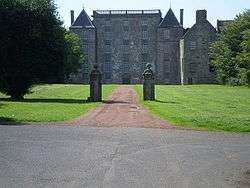 | |
| Location | Bo'ness, Scotland |
| Built | 1553 |
| Built for | James Hamilton, 2nd Lord Hamilton, 1st Earl of Arran |
| Governing body | Historic Environment Scotland |
Kinneil House is a historic house to the west of Bo'ness in east-central Scotland.[1] It was once the principal seat of the Hamilton family in the east of Scotland.[2] The house was saved from demolition in 1936 when 16th-century mural paintings were discovered, and it is now in the care of Historic Scotland. It sits within a public park, which also incorporates a section of the Roman Antonine Wall and the only visible example of an Antonine fortlet available today.[3] A digital reconstruction of the fortlet has been created.[4]
The house now consists of a symmetrical mansion built in 1677 on the remains of an earlier 16th- or 15th-century tower house, with two rows of gunloops for early cannon still visible. A smaller east wing, of the mid 16th century, contains the two painted rooms. The house is protected as a Category A listed building.[5]
Early history
.jpg)
The lands of Kinneil with Larbert and Auldcathy were given to Walter Fitz Gilbert, an ancestor of the Hamilton family by Robert the Bruce in 1323.[6] A charter of 1474 mentions a castle at "Craig Lyown", and the saltpans which added to the estate income.[7] The Castle of Lyon was nearer the sea at Snab Brae, and remembered by the name of Castleloan housing estate.[8]
Parts of an older castle, which replaced the castle at the Snab may be incorporated in the present building. James Hamilton, 1st Earl of Arran died at Kinneil in 1529, but wished to be buried at Hamilton.[9]
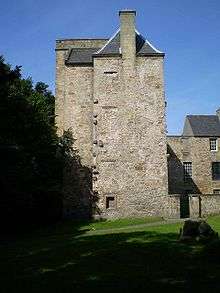
Regent Arran
The east wing of the surviving building, and perhaps the earlier tower with wide-mouthed gunloops, was built by James Hamilton, 2nd Earl of Arran (c.1516–1575). He was the Governor or Regent of Scotland on the death of James V. Some payments were recorded in the royal treasurer's accounts.[10] Coal was shipped from Kinneil to Leith for Edinburgh Castle, and timber for repairing Arran's chamber at 'Craig Lyon' came from Leith in May 1545.[11] Timber for roofing, floors and panelling was sent by boat from Leith in 1549 and 1550 to complete one section.[12]
The garden or "yaird" was improved for the Spring of 1553, by planting trees, hedges, marjoram and lettuce.[13] In September 1553, Arran gave a gift of 44 shillings to masons laying the foundation stones of another part of the Palace. One of the masons was Thomas Bargany and at this time John Scrimgeour of Myres was Arran's master of work or architect.[14]
Wall-paintings
The 16th century painted interior decoration and a stone armorial carry Arran's ducal coronet, and the collar of the Order of Saint Michael, French honours he received in 1548. The stone has the Hamilton motto, the woodsman's cry, "Through!", and the arms of his wife, Margaret Douglas, with her motto "Lock Sickar", meaning secure or steadfast. The armorial stone was formerly set on the north pavilion of the main block, and is now displayed with other carved stones in a cellar.
One of his painted rooms has decoration that evokes verdure tapestry and vignettes of Samson and Delilah, Abraham and Isaac, and David and Bathsheba and The Temptation of St. Anthony; this vaulted room is now called the Arbour Room. The other room has scenes from the Parable of the Good Samaritan, Lucretia, Saint Jerome and Mary Magdalene. The original use of this suite of rooms is unknown.[15] The subjects of these paintings allude to the Power of Women, perhaps a political reference to Mary of Guise, Mary Queen of Scots and the two Tudor Queens of England.
The house was empty on 4 February 1560 when French troops led by d'Oysel attacked and burnt it.[16] On Easter Day 1562, the 3rd Earl of Arran, who suffered from mental ill health, escaped from his father and bedchamber at Kinneil using sheets as a rope. The drop was 30 fathoms.[17] After the battle of Corrichie in October 1562, Arran was the reluctant keeper of George Gordon at Kinneil, the forfeited heir of the Earl of Huntly.[18]
James VI of Scotland
Regent Lennox damaged the house with gunpowder and spoiled the lands after the assassination of Regent Moray at Linlithgow by a Hamilton.[19] James VI reduced the power of the Hamiltons by military force in 1579, and the Duke's wife, Margaret Douglas, and daughter Lady Jean Hamilton, Countess of Eglinton, were brought to Kinneil from Craignethan Castle.[20] In 1581 the king gave their estates and titles to James Stewart. The new Earl often resided at Kinneil until after his own fall in the autumn of 1585, when he remained at Kinneil under house-arrest, and for a time Kinneil was called Arran House.[21]
James VI of Scotland stayed in May 1582, to receive an envoy, Signor Paul, sent by the Duke of Guise with a gift of horses and gunpowder. The visit was controversial because Paul was known to have been involved in the St. Bartholomew's Day massacre. (Some sources say Paul was received at Dalkeith Palace)[22] After the Raid of Ruthven, the Earl of Arran was confined at Kinneil. When the Ruthven regime collapsed, James VI came to banquet at Kinneil with Arran on 13 November 1583. The next day, Ludovic Stewart son of the King's favourite Esmé Stewart arrived from France at Leith and was taken to Kinneil to meet the King.[23]
James VI held court at Kinneil again at Christmas-time in 1588 as the guest of John Hamilton, Commendator of Arbroath. He played at the "maye" (probably the card-game "maw" now called "Forty-fives") with his English courtier, Roger Aston, and told him that the more he did to please Elizabeth the less regard she had of him. The Earl of Huntly, the Earl of Crawford and the Chancellor, John Maitland, were present.[24]
Later history
The Arbour Room was redecorated c.1620 for James Hamilton, 2nd Marquess of Hamilton and his wife Ann Cunningham and the "shakefork" and rabbit supporters of Cunningham heraldry can still be seen. This painting was almost certainly the work of Valentine Jenkins, Englishman and burgess of Glasgow, and painter of the Chapel Royal at Stirling Castle.[25] When Anne died in 1644, she left Kinneil with its new tapestries and the furnishings she had made to her son, James, 1st Duke of Hamilton. She had laboured to make the coal mines and salt pans profitable and urged him to employ faithful servants and never put it out of his own hand.[26]
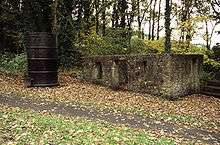
The main house was rebuilt by William Douglas, 3rd Duke of Hamilton in 1677 with a uniform facade and a pair of stone staircases at the ends. He sent his plans to help William Douglas, 1st Duke of Queensberry with his building works, which included Drumlanrig Castle in Dumfriesshire and Queensberry House in Edinburgh.[28] An inventory of 1688 gives the names of rooms in the now gutted main house. The front door opened into a Laich Hall, and a grand stair to the south led to the dining room above. The same arrangement can still be seen at the contemporary Argyll's Lodging, Stirling.[29]
But family use of the house declined, as income from the mines and port increased. In the late 18th century, Dr John Roebuck, founder of the Carron Iron Works lived at Kinneil House,[5] during which time the engineer James Watt worked at perfecting his steam engine, in a cottage adjacent to the house.[30] Between 1809 and 1828 the 9th Duke gave the philosopher Dugald Stewart use of the house.[5]
Ancient Monument
By 1936 the Hamiltons had abandoned the house, and Bo'ness Town Council were demolishing it when Stanley Cursitor, director of the National Galleries of Scotland, heard that new wall paintings had been discovered.[31] The Ministry of Works quickly secured the wing with the paintings, and recovered the oak ribbed ceiling of the Parable Room. The paintings were restored, and the whole building is now in the care of Historic Scotland.
Kinneil Church
The former parish church is to the west of the palace and is a roofless ruin.[32] The west gable survives. One of its bells, now preserved in the nearby Kinneil Museum, has the inscription "-EN KATHARINA VOCOR UT PER ME VIRGINIS ALME -," (I AM CALLED KATHARINE, AND THROUGH ME, OF THE VIRGIN MARY, ARE -) It has been suggested the inscription was completed on a second bell.[33] A large stone cross from the church is kept with the palace.[34]
Ghost
The house is reportedly haunted by a White Lady, believed to be the ghost of Lady Alice who killed herself by leaping from the building in the 17th Century to escape her cruel husband.[35]
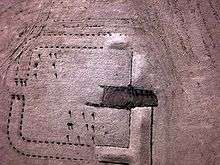
Lady Alice or Ailie was traditionally supposed to haunt the nearby glen of the Gil Burn.[36]
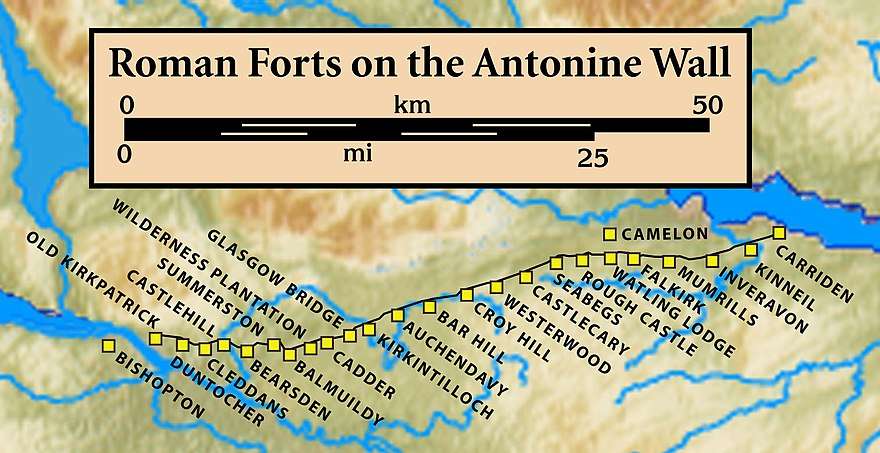
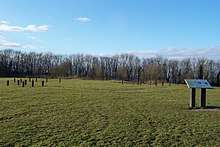
The Antonine Wall
Historically it was thought that there may have been a Roman Fort near Kinneil House.[37] Sir George Macdonald speculated about a fortlet near the house.[38]
In July 1961 two sites in Bo’ness were excavated. This followed on from previous excavations carried out in 1960 which were sponsored by the Inspectorate of Ancient Monuments, Ministry of Public Buildings and Works. The first site was located in a field near Kinneil House.[39] The excavation revealed laid firestone blocks which once formed part of the wall base. These were partially destroyed with only one kerbstone still remaining.[40]
In the 1970s a Roman fortlet was located and two timber buildings. A short section of the Antonine rampart has been reconstructed.[41] Kinneil has the only visible example of an Antonine fortlet available today. Among the finds at the site a Roman horse harness loop was found.[42]
A detailed video of the copper alloy harness fitting is available online.[43] A fine leather shoe from the fortlet has also been digitally reconstructed.[44] A single Roman coin was also found.[45]
In 2018, nine trenches were opened at Kinneil. These revealed the remains of a metalled surface, well preserved in one trench, which were possibly part of the Military Way.[46]
References
- ↑ "OS 25 inch 1892-1949". National Library of Scotland. Ordnance Survey. Retrieved 26 October 2017.
- ↑ Salmon, Thomas James (1913). Borrowstounness and district, being historical sketches of Kinneil, Carriden, and Bo'ness, c. 1550-1850. Edinburgh: William Hodge and Co. pp. 44–52. Retrieved 9 December 2017.
- ↑ "KINNEIL: FORTLET" (PDF). Frontiers of the Roman Empire. Retrieved 9 December 2017.
- ↑ "Reconstruction of fortlet, Kinneil". Retrieved 19 May 2018.
- 1 2 3 "Kinneil House, Listed Building Report". Historic Scotland. Retrieved 2010-05-13.
- ↑ HMC 11th Report and Appendix part vi, Hamilton, (1887), 3, 12-13.
- ↑ HMC (1887), 19: Register of the Great Seal, vol. ii (1882), no. 1177
- ↑ Salmon, Thomas, James, Borrowstouness & district, (1913), p.458, is mistaken in attributing the name to "Lyon of Glamis" of a later date. ("Loan", usually "lane", may here be derived from "Lyon.")
- ↑ HMC (1887), 52-3.
- ↑ Accounts of the Lord High Treasurer of Scotland; vol. 8 (1908); vol. 9 (1911); vol. 10 (1913).
- ↑ Accounts of the Lord High Treasurer of Scotland, vol. 8 (1908), 371, 372.
- ↑ Accounts of the Lord High Treasurer of Scotland, vol. 9 (1911), 325, 336-337, 443-444.
- ↑ Accounts of the Lord High Treasurer of Scotland, vol. 10 (1913) 127, 144, 155, 160, 168, 174.
- ↑ Accounts of the Lord High Treasurer of Scotland, vol. 10, (1913), 206, 207, 211.
- ↑ Richardson, J. S. (1940–41). "Mural Decoration at Kinneil House" (PDF). Proceedings of the Society of Antiquaries of Scotland. 75: 184–204.
- ↑ Calendar of State Papers relating to Scotland, vol. 1 (1898), 310, 313.
- ↑ Calendar of State Papers relating to Scotland, vol.i, (1898), 613, 616.
- ↑ Bain, Joseph, ed., Calendar of State Papers Scotland, vol.1 (1898), 668
- ↑ CSP Scotland, vol. 3, (1903), 193, 437, 454.
- ↑ CSP Scotland, vol. 5, (1907), 339.
- ↑ CSP Scotland, vol. 6, (1910), 326.
- ↑ Tytler, Patrick Fraser, The History of Scotland, vol. 4 (1879), 43-4 citing Calderwood: CSP Scotland. vol.6 (1910), nos. 112, 115, 120; no.120 contradicts Calderwood's account by placing John Durie's confrontation with Paul on Edinburgh's Royal Mile.
- ↑ Moysie, David, Memoirs of the Affairs of Scotland, vol.1 (1830), p.147
- ↑ Calendar State Papers Scotland, vol.9 (1915), pp.653-6.
- ↑ Marshall, Rosalind K., The Days of Duchess Anne (Collins, 1973), 58.
- ↑ HMC 11th Report, Appendix Part VI, Duke of Hamilton (London, 1887), 56.
- ↑ "Scotland's 'hidden gems' revealed in public vote". BBC. South Scotland. 1 August 2017. Retrieved 10 December 2017.
- ↑ HMC 15th Report, Appendix Part VIII, Buccleuch & Queenberry, Drumlanrig (London, 1897), 229, 231 nos. 133, 136.
- ↑ Marshall, Rosalind K., The Days of Duchess Anne, (Tuckwell, East Linton, 2000), 261-266, (not included in first edition).
- ↑ "James Watt's Cottage". CANMORE. Royal Commission on the Ancient and Historical Monuments of Scotland. Retrieved 2010-05-13.
- ↑ A wall-painting in the gallery level was lost, picture in RCAHMS Inventory, West Lothian.
- ↑ Rohl, Darrell, Jesse. "More than a Roman Monument: A Place-centred Approach to the Long-term History and Archaeology of the Antonine Wall" (PDF). Durham Theses. Durham University. Available at Durham E-Theses Online ref: 9458. Retrieved 14 October 2017.
- ↑ Salmon (1913), 48-50
- ↑ "Church (12th Century), Cross (Period Unassigned), Gravestone(S) (14th Century), Gravestone(S) (17th Century)". CANMORE. Royal Commission on the Ancient and Historical Monuments of Scotland. Retrieved 2017-11-14.
- ↑ "Halloween happenings in your area". BBC News. 2010-10-22.
- ↑ Salmon, Borrowstouness & District, (1913), p.47 see external links
- ↑ "Kinneil". CANMORE. Royal Commission on the Ancient and Historical Monuments of Scotland. Retrieved 2017-11-14.
- ↑ Macdonald, Sir George (1934). The Roman wall in Scotland, by Sir George Macdonald (2d ed., rev., enl., and in great part rewritten ed.). Oxford: The Clarendon press. pp. 191–192. Retrieved 11 October 2017.
- ↑ "Bo'ness, Kinneil House". CANMORE. Royal Commission on the Ancient and Historical Monuments of Scotland. Retrieved 2017-11-14.
- ↑ Hendry, T. A. (1971). "Antonine Wall Excavations Kinneil Sector". Glasgow Archaeological Journal. 2: 107–110 – via (https://doi.org/10.3366/gas.1971.2.2.107).
- ↑ "Kinneil". CANMORE. Royal Commission on the Ancient and Historical Monuments of Scotland. Retrieved 2017-11-14.
- ↑ "Kinneil". Antonine Wall- site by site. Retrieved 9 December 2017.
- ↑ "Harness Fitting, Kinneil". Retrieved 9 December 2017.
- ↑ "Shoe reconstruction, Kinneil". Retrieved 9 December 2017.
- ↑ "Kinneil Antonine Wall Fortlet & Camps". Roman Britain. Retrieved 9 December 2017.
- ↑ Krakowka, Kathryn. "Connecting the dots at Kinneil House" (344). Current Archaeology. Retrieved 1 October 2018.
Further reading
- Morag Cross and Dennis Gallagher, Bibliography of Properties in Care, vol. 2, Historic Scotland (2003), 491-493.
- RK Marshall, in Gow & Rowan ed., Scarce Finer a seat in Scotland (1995), 'Kinneil and the 4th Duke of Hamilton'
- MacGibbon & Ross, Castellated & Domestic Architecture of Scotland, vol. iii (1887), 228-231
- "Kinneil House". CANMORE. Royal Commission on the Ancient and Historical Monuments of Scotland. Retrieved 2010-05-13.
External links
| Wikimedia Commons has media related to Kinneil House. |